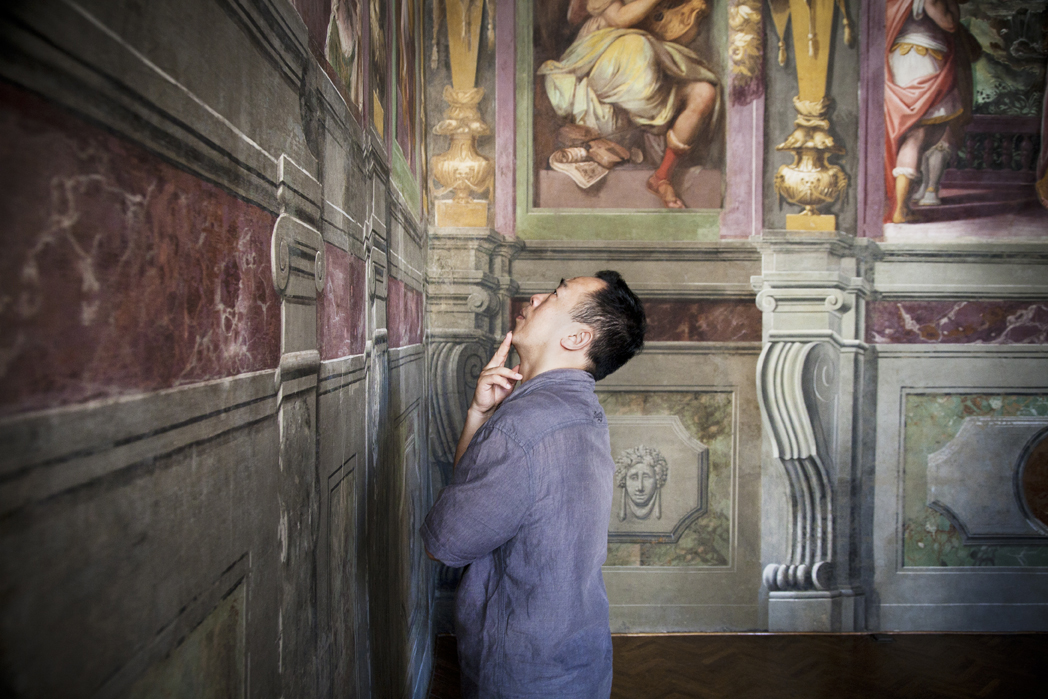
Connecting Art Histories participants studying frescoes in the Casa Vasari palace in Florence, Italy.
Sixteen Chinese scholars with an enduring passion for Renaissance art and architecture are finally seeing glorious Italian masterworks in person—and sharing new ideas about art history with one another and with European and American colleagues as part of a unique Getty Foundation grant initiative called Connecting Art Histories.
The vitality of any scholarly discipline rests on the ability to forge connections among people and ideas across national and international boundaries. Connecting Art Histories, initiated in 2009, is making a difference by funding creative opportunities for sustained intellectual exchange in parts of the world where art history is an emerging field of study.
In many cases, scholars reside in regions whose economic or political realities have prevented the kind of international collaboration and dialogue that keeps any discipline strong. The Getty Foundation is tackling these challenges by connecting art historians from around the world to one another, in order to transform our understanding and interpretation of the world’s artistic heritage.
The Foundation is making these connections in two ways—the first is providing funding to international art history departments to expand their curriculum by bringing professors from other parts of the world to teach courses the host department has not previously offered.
One example is a grant to a leading postgraduate university in India, Jawaharlal Nehru University in New Delhi. The university’s School of Art and Aesthetics is a leader in the study of Indian art and popular culture, and the Foundation grant has enabled the program to expand its range of art history graduate courses through a Distinguished Visiting Professorship program. The program has brought senior scholars to the university each year to teach courses in diverse areas such as ancient Roman art, Islamic art, and contemporary art theory.
Other grants are supporting intensive seminar-type programs that bring together teams of scholars from various countries to conduct sustained research, creating lasting intellectual networks in the process. (See this post last year about another Getty research team of individuals from 10 different countries delving into the unique artistic materials used in the 16th—18th century Spanish Viceroyalties.)
The group of Chinese scholars in Italy is another example of scholarly exchange that traverses international boundaries. The group has been based in Florence at the Villa I Tatti – Harvard University Center for Italian Renaissance Studies, and recently completed a three-week seminar designed specifically for historians of both art and architecture in China. Participants came together from 16 different institutions across mainland China and Taiwan, many of them meeting each other for the first time.

Chinese scholar and Connecting Art Histories participant Liang Guo views frescoes in the Casa Vasari palace in Florence, Italy.
The program focused on the unity of the arts during this time period, drawing on early Italian art historian Giorgio Vasari’s concept of disegno as an underlying principle of design and drawing that unites and underlies all arts.
Throughout, participants met at I Tatti to discuss readings and conduct research, while also spending time each week in the city’s numerous museums, churches, piazzas, and monuments, as well as on site visits with former research fellows.
And the exchange isn’t one-way. I Tatti program co-director Jonathan Nelson commented, “Over the course of the seminar, I learned about differences between the organization of public spaces in Renaissance Italy and in Ming China, and similarities in how mural painters from both regions considered the viewers’ point of observation. But perhaps more importantly, our colleagues from across mainland China and Taiwan had an opportunity to build a lasting network for Renaissance studies.”
Given the Foundation’s aim of using the Connecting Art Histories initiative to increase intellectual dialogue across regional and national borders, the I Tatti program has succeeded beautifully in connecting Chinese scholars—who have often worked in isolation—with one another and with colleagues in the West. Chinese participants say the program has had an important impact.
“Renaissance art has always been an important part of the western art history teaching curriculum. But it can be difficult to teach this subject in China, due to the limited text and image resources available,” acknowledged Chinese scholar Yiyang Shao. “Having had the opportunity to attend the Villa I Tatti program with other Chinese scholars who specialize in this area has been a great experience for us to access real art works and original archives. The program has certainly made us understand Renaissance art more broadly and deeply, and all these advantages will be passed through our teaching and writings in China.”
As well as the Villa I Tatti grant, the Getty Foundation also is currently funding two other Connecting Art Histories programs organized by partners from Italy.
One team of participants from across Central Asia, the Mediterranean basin, and Europe and led by researchers from the Kunsthistorisches Institut in Florence is studying the mobility of cultural objects along trade routes like the historic Silk Road—proving that globalism is not only a 21st-century phenomenon.
At the same time, the American Academy in Rome is organizing a study of medieval art and architecture across the Mediterranean, including North Africa, the Middle East, and the Balkan coast. While today this region is often characterized by divisive religious and ethnic tensions, new research is revealing a more integrated history of the medieval period, uncovering a distinctive blend of Judaism, Christianity, and Islam that shaped art and culture during this era.
These projects and many others supported through Connecting Art Histories are an important outreach effort in forging genuine, vital intellectual exchanges that are shaping the future of art history for the better by connecting the art historical dots around the globe.




Comments on this post are now closed.